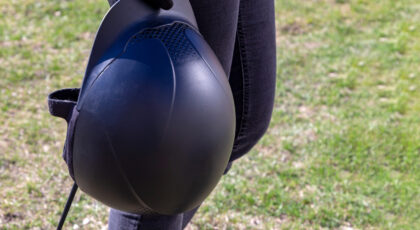A long rider, according to the Long Rider’s Guild, is someone who has ridden more than 1,000 continuous miles on a single equestrian journey.
Bernice Ende has ridden over 30,000 miles on horseback since 2005, by herself, across the U.S. and Canada. Her longest ride—traveling coast-to-coast and back, dating from 2014–2016—covered an epic 8,000 miles.
I first encountered the “Lady Long Rider” on the page.
As a book lover with a proclivity to read about women who have endeavored and achieved the impossible, I was drawn to her book, Lady Long Rider: Alone Across America on Horseback. I quickly learned at the root of her long rides pursuit is the sentiment that her freedom to ride was won by the courageous suffragists, who over a hundred years ago, never gave up their fight for equality.
“It is these women, including my maternal grandmother and great aunts,” Bernice says, “who cleared a wide path for me to travel where there was once no path at all.”
In her rides, in her book, and in her countless appearances across the country, Bernice’s mission has been to encourage women to strive for greater participation in leadership.
“Right or left makes no difference to me,” she says. “But women need to go beyond their fears and become more active in political, social and economic areas, standing beside men, not behind, in making world changes.”
Ironically, many assume Bernice longs for a simpler time. Her ability to weather the terrain and elements and live in simplicity off the land with her horses often prompts people to remark: “I bet you wish you lived a hundred years ago” is a common remark.
Bernice’s reply is always the same. “But I wouldn’t have been able to vote!”
RELATED: Read “I Met My Hero at EQUUS Film Festival“
“President Wilson! How long must women wait for liberty?”
Suffragists began their organized fight for women’s equality in 1848, when they demanded the right to vote during the Seneca Falls Convention.
Sentiment among the male population—post the Civil War (1861–1865)—ranked among President Wilson’s: “Girls aren’t smart enough to vote.” Theologian Lyman Abbott, writing for The Atlantic in 1903, described women who would attempt “man’s function” as “monstrosities of nature.”
That mindset continued for decades. Before World War I (1914–1918), suffragists were claimed to have been instigating a “petticoat coup,” destroying the family unit. In the New York Times in 1913, a reporter wrote, “All the rumpus about female suffrage is made by a very few of our disoriented sisters.”
In the spring of 1917, the President was a “firm believer” in liberty and was quoted as saying, “liberty is the fundamental demand of the human spirit,” but would close his eyes as he was driven past the women protesting for their right to vote outside the White House. He realized these women weren’t going to stand down and could no longer ignore their plea.
The Passage of the 19th Amendment
Since the 1848 Seneca Falls Convention, women leaders relentlessly protested for the right to the ballot. Even still, it was some 70 years until the U.S. House of Representatives approved the Susan B. Anthony Amendment on May 21, 1919. The U.S. Senate followed suit two weeks later on June 4, 1919.
Before it could be added to the Constitution, the 19th Amendment needed to be ratified by 3/4ths of the-then-48 states. On August 18, 1920, Tennessee became the last state needed. And on August 26, 1920, U.S. Secretary of State Bainbridge Colby issued a proclamation declaring the 19th Amendment part of the U.S. Constitution, forever protecting American women’s right to vote.
We’ve come far, but …
The quickly approaching centennial of the 19th Amendment’s passage is a cause for celebration and we continue to see women’s progress in playing a transformative role in political arenas. More women than ever before are running for Congress and governorships and serving in the House and in the Senate.
But the feminist movement is still thwarted by many of the same hindrances that complicated the fight for voting rights a hundred years ago. When will we see our first woman president? Our fight for equality continues.
And Bernice remains committed to her role in it.
Before the pandemic, she and her support team began organizing the “Lady Long Rider’s Suffragist Tour” in honor of the centennial. Bernice and her horses were to launch the tour with the 4th of July parade in Choteau, Montana. She would have then ridden to the home of Janette Rankin in Helena, the first woman senator. In Rochester, New York, she had planned to visit the homes of Susan B. Anthony, Matilda Joslyn Gage and Elizabeth Cady Stanton. The tour was to include a stop at Seneca Falls.
As with many events this year however, the Suffragist Tour has been cancelled due to COVID-19. But her fight for equality and epic travels continues—on the page and the screen. Bernice has started a second book with the working title, “Mothers, Aunts, Suffragettes, and Lady Long Riders.” The documentary by W+E1 Productions about her life will be entered in the EQUUS Film and Arts Fest November 2020 at the Kentucky Horse Park.
The road to equality may be long and difficult to navigate. But that’s exactly what the Lady Long Rider does best.
Learn more about Bernice at www.endeofthetrail.com.

Pick up a copy of Lady Long Rider: Alone Across America on Horseback on Equishopper!


 July 23, 2020
July 23, 2020 

























